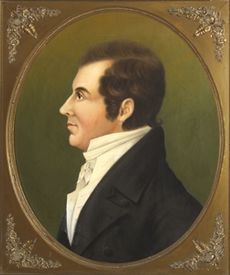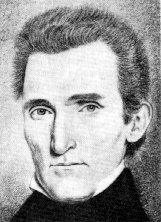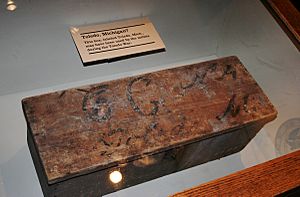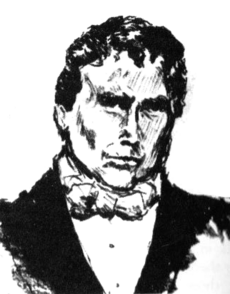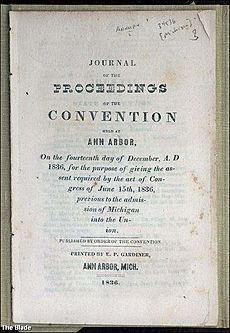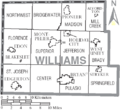Toledo War facts for kids
Quick facts for kids Toledo War |
|||||||||
|---|---|---|---|---|---|---|---|---|---|
 The portion of the Michigan Territory claimed by the State of Ohio known as the Toledo Strip |
|||||||||
|
|||||||||
| Belligerents | |||||||||
| Ohio militia | Territory of Michigan militia | ||||||||
| Commanders and leaders | |||||||||
| Robert Lucas John Bell |
Stevens T. Mason Joseph W. Brown |
||||||||
| Strength | |||||||||
| 600 | 1,000 | ||||||||
| Casualties and losses | |||||||||
| none | 1 wounded | ||||||||
| In exchange for ceding the Toledo Strip, all of what is now known as the Upper Peninsula was included within Michigan's bounds when it was admitted into the Union in 1837 (only the easternmost portion of the peninsula had been claimed in Michigan's 1835 statehood petition). | |||||||||
The Toledo War (1835–36) was a border disagreement between the U.S. state of Ohio and the Territory of Michigan. It was also called the Michigan–Ohio War. This "war" was mostly peaceful, with almost no fighting. The dispute was over a piece of land known as the Toledo Strip. Both sides wanted this land because it had good farmland. It also offered important shipping routes through the Maumee River to Lake Erie.
Mistakes in early maps of the Great Lakes caused the problem. Laws passed between 1787 and 1805 had different ideas about the border. This led both Ohio and Michigan to claim the same 468 square miles (1,212 km2) of land. The situation became serious in 1835 when Michigan wanted to become a state. It tried to include the disputed land in its new borders.
Both Ohio and Michigan passed laws to try and control the area. Ohio's Governor Robert Lucas and Michigan's young Governor Stevens T. Mason were key figures. They made it difficult for people to follow the other side's rules. Both states sent their militias to the Maumee River near Toledo, Ohio. However, there was little actual fighting. The only real clash involved some shots fired into the air, with no one seriously hurt.
In 1836, the United States Congress offered a deal. Michigan would give up the Toledo Strip. In return, it would become a state and gain the entire Upper Peninsula. At first, Michigan thought this was a bad deal. The Upper Peninsula seemed like a worthless wilderness. Voters rejected the offer in September. But by December, Michigan faced money problems. Under pressure from Congress and President Andrew Jackson, Michigan accepted the deal. This agreement, called the "Frostbitten Convention," ended the Toledo War. Michigan became a state in 1837. Later, the Upper Peninsula's rich minerals became very valuable.
Contents
Why Did the Toledo War Happen?

The conflict started because of old maps and laws. In 1787, the Northwest Ordinance created the Northwest Territory. This huge area was meant to be divided into several new states. The law said one border would be "an east and west line drawn through the southerly bend or extreme of Lake Michigan".
When Ohio was becoming a state in 1802, its border description was similar. It said the line would run east from Lake Michigan's southern tip. It would continue until it met Lake Erie or the Canadian border.
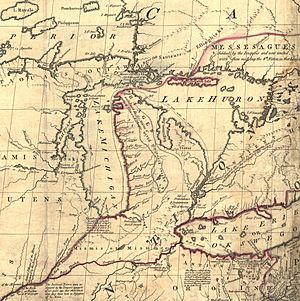
The best map at the time, the "Mitchell Map", showed Lake Michigan's southern tip quite far north. This meant the east-west line would likely cross Lake Erie. Ohio wanted to control the important Maumee River mouth and the Lake Erie shoreline.
However, some people heard that Lake Michigan actually extended much farther south. If true, the border line might miss Lake Erie entirely. Or it might cut off a lot of land Ohio wanted. To protect its interests, Ohio added a special rule to its state constitution. If Lake Michigan was farther south, the border would angle northeast. This would ensure Ohio got the Maumee River area and the southern Lake Erie shore.
The U.S. Congress accepted Ohio's constitution. But they noted that Lake Michigan's exact position wasn't known. When the Michigan Territory was created in 1805, Congress used the original Northwest Ordinance language. They did not include Ohio's special angled border rule. This difference in the laws set the stage for the Toledo War 30 years later.
What Was the Toledo Strip?

The border was argued about for many years. People in the Port of Miami (later Toledo) asked Ohio to fix the border. Ohio's government repeatedly asked Congress to solve the problem. In 1812, Congress agreed to an official survey. This was delayed by the War of 1812.
After Indiana became a state in 1816, the survey began. The border between Michigan and Indiana was moved north. This gave Indiana more Lake Michigan shoreline. The U.S. Surveyor General, Edward Tiffin, was in charge of the survey. He was a former Ohio governor. He hired William Harris to survey the line Ohio wanted, not the original Ordinance Line.
This "Harris Line" placed the Maumee River mouth entirely in Ohio. When the survey results came out, Michigan's governor, Lewis Cass, complained. He said the survey favored Ohio. Michigan then ordered its own survey by John A. Fulton. The Fulton survey followed the original 1787 Ordinance Line. It found the Ohio border to be southeast of the Maumee River mouth.
The land between the Harris and Fulton survey lines became the "Toledo Strip." This strip of land was 5 to 8 miles (8 to 13 km) wide. Both Ohio and Michigan claimed it. Ohio refused to give up its claim. Michigan quietly controlled the area for several years. It set up local governments, built roads, and collected taxes there.
Why Was the Toledo Strip Important?
The Toledo Strip was very important for trade and farming. Before railroads, rivers and canals were the main ways to move goods in the Midwest. The area around Toledo was hard to travel by road because of the Great Black Swamp. The Maumee River flowed into Lake Erie. It was a key connection to Fort Wayne, Indiana.
There were plans to connect the Mississippi River and the Great Lakes with canals. Ohio planned the Miami and Erie Canal in 1825. This canal would link to the Ohio River and Lake Erie via the Maumee River.
The successful Erie Canal (finished in 1825) connected New York City to the Great Lakes. This made trade and travel much easier. Farm products from the Midwest could be shipped east cheaply. Many settlers moved to the Midwest.
The success of the Erie Canal inspired more canal projects. The western end of Lake Erie offered the shortest route to Indiana and Illinois. So, Maumee Harbor was seen as a very valuable location. Detroit was farther from Lake Erie and faced the Great Black Swamp. This made Toledo a better spot for new transportation projects like canals and later railroads. Both states knew controlling the Toledo Strip would bring great wealth.
Also, the land west of Toledo was excellent for farming. It had fertile soil and produced large amounts of corn and wheat. Both Michigan and Ohio wanted this prosperous farmland and important port.
What Led to the Conflict?
By the early 1820s, federal land surveys reached the disputed area. For some reason, the Surveyor General ordered the surveys to follow Michigan's line, not Ohio's. This suggested Michigan's claim was stronger. Townships north of this line believed they were part of Michigan.
By the 1820s, Michigan Territory had enough people (60,000) to become a state. But when it asked to hold a state meeting in 1833, Congress said no. The Toledo Strip dispute was still unresolved.
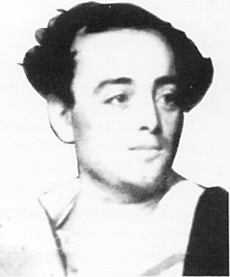
Ohio argued that its border was already set in its constitution. It saw Michigan's citizens as trespassers. Ohio's government refused to discuss the issue. Ohio's representatives in Congress worked to stop Michigan from becoming a state. In January 1835, Michigan's young governor, Stevens T. Mason, decided to act. He called for a state meeting in May, even without Congress's approval.
In February 1835, Ohio passed laws to set up county governments in the Strip. The county where Toledo was located was named Lucas County, after Governor Robert Lucas. This made Michigan even angrier. Ohio also tried to get Congress to officially set the border as the Harris Line.
Michigan, led by the energetic Mason, responded quickly. Six days after Lucas County was formed, Michigan passed the Pains and Penalties Act. This law made it a crime for Ohio officials to act in the Strip. Those who did could face fines or imprisonment. Governor Mason, as the territory's leader, prepared his militia. He told Brigadier General Joseph W. Brown to be ready to stop Ohio's actions. Governor Lucas also got approval for his own militia. He soon sent forces to the Strip. The Toledo War had officially begun.
Former U.S. President John Quincy Adams, then a Congressman, supported Michigan. He said that Michigan clearly had the right, but Ohio had all the power.
The "War" Begins
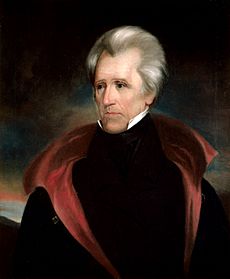
On March 31, 1835, Ohio Governor Lucas arrived in Perrysburg, Ohio, with about 600 armed militia members. Perrysburg was 10 miles (16 km) southwest of Toledo. Soon after, Governor Mason and General Brown arrived in Toledo with about 1,000 armed men. Their goal was to stop Ohio from moving into Toledo and marking the border.
President Jackson Steps In
President Andrew Jackson wanted to avoid a real fight. He asked his Attorney General, Benjamin Butler, for legal advice. Ohio was a powerful state with many representatives in Congress. Michigan was still a territory with only one non-voting delegate. Ohio was important for Jackson's political party. Jackson thought it best to keep the Toledo Strip for Ohio. However, Butler said the land legally belonged to Michigan until Congress decided otherwise. This put Jackson in a difficult spot.

On April 3, 1835, Jackson sent two representatives, Richard Rush and Benjamin Chew Howard, to Toledo. They were there to help settle the conflict. On April 7, they offered a compromise. They suggested that Michigan allow Ohio to re-survey the Harris Line. Also, people in the disputed area could choose which government to follow until Congress made a final decision.
Lucas agreed to the plan and started sending his militia home. He thought the issue was settled. Three days later, elections were held in the region under Ohio law. Mason, however, refused the deal. He continued to prepare for possible fighting.
During the elections, Michigan officials bothered Ohio voters. They threatened people with arrest if they followed Ohio's rules. On April 8, 1835, a Michigan sheriff arrested two Ohioans. They were accused of voting in the Ohio elections.
The Battle of Phillips Corners
After the election, Lucas believed the situation was calm. He sent surveyors out again to mark the Harris Line. The work went smoothly until April 26, 1835. Then, 50 to 60 members of General Brown's Michigan militia attacked the surveying group. This event is known as the Battle of Phillips Corners. It was the only time armed forces clashed.
The surveyors later wrote to Lucas about the attack. They said Michigan militia told them to leave. During the chase, "nine of our men... were taken prisoners." Michigan claimed they only fired a few musket shots into the air as the Ohio group ran away. No one was hurt. But this clash made both Ohioans and Michiganders even angrier. It brought them very close to a full-scale war.
Tensions Rise in 1835
After Michigan's militia allegedly fired shots, Governor Lucas called a special meeting of Ohio's legislature on June 8. They passed more laws. These included making Toledo the county seat of Lucas County. They also set up a court in Toledo. A law was passed to prevent Ohio citizens from being taken from the area. Ohio also set aside $300,000 to carry out these laws. Michigan's legislature responded by setting aside $315,000 for its own militia.
In May and June, Michigan wrote a state constitution. It planned for a legislature, a supreme court, and other parts of a state government. But Congress still would not let Michigan become a state. President Jackson said he would not allow Michigan to join the Union until the border dispute was settled.
Lucas's adjutant general, Samuel C. Andrews, reported that 10,000 Ohio volunteers were ready to fight. This news spread and became exaggerated. Michigan newspapers dared the Ohio "million" to enter the Strip.
In June 1835, Lucas sent a group to Washington D.C. to talk with President Jackson. They presented Ohio's case and urged Jackson to act quickly.
Throughout mid-1835, both governments continued to challenge each other. There were constant small clashes and arrests. People from Monroe County, Michigan, formed a group to make arrests in Toledo. Ohio supporters, angry about this, started their own legal actions. Lawsuits were common, leading to more lawsuits from the other side. Both sides also spied on the sheriffs of Wood County, Ohio, and Monroe County, Michigan.
On July 15, a Michigan deputy sheriff went to Toledo to arrest Major Benjamin Stickney. When Stickney and his family resisted, they were all taken into custody. During the struggle, the major's son, Two Stickney, injured the deputy and ran into Ohio. The deputy's injuries were not life-threatening. Mason demanded that Lucas send Two Stickney to Michigan for trial. Lucas refused. Mason then asked Jackson for help, suggesting the U.S. Supreme Court resolve the issue. At that time, it was not clear if the Supreme Court could settle state border disputes. Jackson declined. Lucas then tried to end the conflict through federal help from Ohio's Congress members.
In August 1835, because Ohio's Congress members pushed hard, Jackson removed Mason as Michigan's governor. He appointed John S. Horner instead. Before Horner arrived, Mason ordered 1,000 Michigan militia members to enter Toledo. He wanted to stop the first session of Ohio's court there. This idea was popular in Michigan, but it failed. The judges held a quick midnight court session. Then they quickly moved south of the Maumee River, where Ohio forces were waiting.
The Frostbitten Convention Ends the War
Horner was not popular as governor and his time in office was short. People disliked him so much they burned his image and threw vegetables at him. In the October 1835 elections, voters approved Michigan's constitution. They also re-elected Mason as governor. Isaac E. Crary was chosen as Michigan's first U.S. Representative. But because of the dispute, Congress would not let him vote. The two U.S. Senators chosen by Michigan, Lucius Lyon and John Norvell, were only allowed to watch from the Senate gallery.
On June 15, 1836, President Jackson signed a bill. It allowed Michigan to become a state, but only if it gave up the Toledo Strip. In return, Michigan would get the western three-quarters of the Upper Peninsula. (The eastern part was already included). People thought the Upper Peninsula was a worthless wilderness, not good for farming. So, in September 1836, a special meeting in Ann Arbor rejected the offer.
As the year went on, Michigan faced a serious money crisis. The high costs of the militia had almost bankrupted the government. Michigan realized that a large sum of money from the U.S. Treasury was about to be given to the 25 states. As a territory, Michigan would not get any. This pushed the government to act.

The "war" unofficially ended on December 14, 1836. A second meeting in Ann Arbor took place. Delegates voted to accept Congress's terms. Calling this meeting was controversial. It happened because many private groups and public meetings pushed for it. Since the legislature did not officially approve the meeting, some said it was illegal. The Whigs refused to attend. So, many Michigan residents made fun of the decision. Congress questioned if the meeting was legal, but they accepted its results. Because of these issues and a very cold spell, the event became known as the Frostbitten Convention.
On January 26, 1837, Michigan officially became the 26th state. It did not get the Toledo Strip, but it gained the entire Upper Peninsula.
What Happened After the War?
The Toledo Strip became a permanent part of Ohio. Most people at the time thought the Upper Peninsula was a useless wilderness. They believed it was only good for timber and fur trapping. However, in the 1840s, copper was found in the Keweenaw Peninsula. Iron was found in the Central Upper Peninsula. This led to a huge mining boom that lasted for many years. Michigan lost 1,100 square miles (2,800 km2) of farmland and the port of Toledo. But it gained 9,000 square miles (23,000 km2) of land rich in timber and ore.
Disagreements about the exact border continued until a new survey in 1915. The surveyors usually follow the original line exactly. But this time, they made small changes in places. This was to prevent people from suddenly living in a different state. It also stopped landowners from having property in both states. The 1915 survey used 71 granite markers. When it was finished, the governors of Michigan and Ohio shook hands at the border.
You can still see traces of the original Ordinance Line today. The northern borders of Ottawa and Wood counties follow it. Many township borders in Fulton and Williams counties do too. Many old north-south roads have a slight jog where they cross the line. This forces traffic to move east when going north. Maps show this line as the "South Michigan Survey" or "Old State Line Road."
While the land border was set, the two states still argued about the border in Lake Erie. In 1973, they went to the U.S. Supreme Court. In the case Michigan v. Ohio, the court ruled that the border in Lake Erie angled northeast. This was as described in Ohio's constitution. One result was that Turtle Island, near Maumee Bay, was split between the two states.
This decision was the last border change. It finally ended years of debate. Today, there is still a friendly rivalry between Michigan and Ohio. This is mostly seen in college American football between the Michigan Wolverines and Ohio State Buckeyes. It also appears in baseball between the Detroit Tigers and Cleveland Guardians. The Toledo War is sometimes seen as the start of this rivalry.
Images for kids
-
USGS topographic map that shows the Ordinance Line as "South Bdy Michigan Survey". There are jogs in many north–south roads at this line.
-
The northern tier of townships in Williams County are within the Toledo Strip. The southern boundary of each lies along the Ordinance Line.
-
The northern half of Dover Township in Fulton County Ohio, formerly claimed by Michigan, is shifted, or "jogs", at "Old State Line Road", now County Road K.


